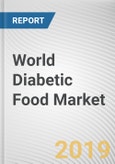The major driver for the growth of the Diabetic Food market is the increasing diabetic population. Rising awareness about the health issues, diabetic concerns and increasing obesity are also contributing to the growth of the Diabetic Food market. However, relatively high price of the products are hampering the growth of the market. Increasing awareness of the Diabetic Food products and the rising consumption of sugar substitute are expected to create lot of opportunities for the growth of the Diabetic Food market.
Diabetic Foods Application Market Analysis
Diabetic Food application market is segmented into confectionary, ice creams & jellies, dietary beverages, snacks, baked products, dairy products and others. Dietary beverages are the largest revenue generating segment due to varied products of dietary beverages and relatively large consumption of the beverages globally.
Diabetic Foods Geography Market Analysis
Geographically, Market is segmented into North America, Europe, Asia Pacific and RoW. North America is the largest revenue-generating segment due to the largest population pool that is suffering from chronic diseases and relatively more number of health conscious population.
Competitive Landscape
The key strategies adopted by the companies to expand in the Diabetic Food Market are product launches, mergers & acquisitions and agreements & collaborations. These strategies would yield strong performing products. Top players in the market are Nestle Golden Farm Candies, Uniliver, Kellogg, Cadbury, Mars, and PepsiCo.
High level Analysis
The report presents detailed analysis of Diabetic Food market using Porter’s five forces model. According to porter’s analysis, the bargaining power of the supplier is high due to high cost of switching. The bargaining power of buyer is low due to the specialized products of Diabetic Food market. Threat of new entrants is high, as business needs moderately high capital investment.
KEY BENEFITS
The study helps to analyze the Diabetic Food market trends to provide in-depth knowledge of the market segment and thus, helps the market players to build viable strategies
To classify competitive strategies adopted by the crowned players and thus, assist the stakeholders in making business decisions
Porter’s five forces model helps to understand the scope of the bargaining power of buyers and suppliers and threat of the new entrants
Analysis of the current market scenario, forecasts of the future transition trends and projected revenue of the market through 2013-2020 are expounded in the report; thus, help stakeholders analyze the market
The analysis focuses on the wide range of opportunities for the enlargement and expansion of the market
KEY DELIVERABLES
Diabetic Food Market Analysis is classified according to applications and geographies.
MARKET BY APPLICATIONS
Confectionary
Ice Creams and Jellies
Dietary Beverages
Snacks
Baked Products
Dairy Products
Others
MARKET BY GEOGRAPHY
North America
Europe
Asia Pacific
RoW
Methodology
The analyst offers exhaustive research and analysis based on a wide variety of factual inputs, which largely include interviews with industry participants, reliable statistics, and regional intelligence. The in-house industry experts play an instrumental role in designing analytic tools and models, tailored to the requirements of a particular industry segment. The primary research efforts include reaching out participants through mail, tele-conversations, referrals, professional networks, and face-to-face interactions.
They are also in professional corporate relations with various companies that allow them greater flexibility for reaching out to industry participants and commentators for interviews and discussions.
They also refer to a broad array of industry sources for their secondary research, which typically include; however, not limited to:
- Company SEC filings, annual reports, company websites, broker & financial reports, and investor presentations for competitive scenario and shape of the industry
- Scientific and technical writings for product information and related preemptions
- Regional government and statistical databases for macro analysis
- Authentic news articles and other related releases for market evaluation
- Internal and external proprietary databases, key market indicators, and relevant press releases for market estimates and forecast
Furthermore, the accuracy of the data will be analyzed and validated by conducting additional primaries with various industry experts and KOLs. They also provide robust post-sales support to clients.

LOADING...








